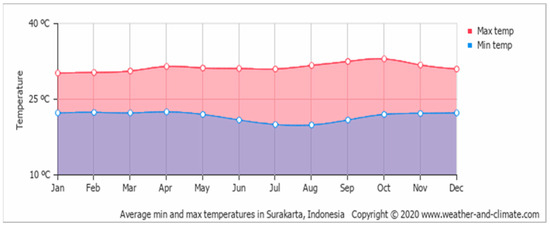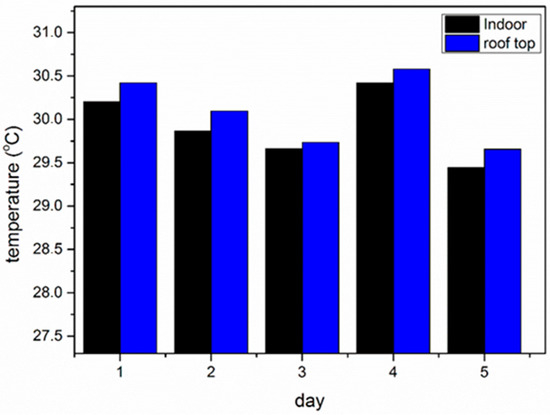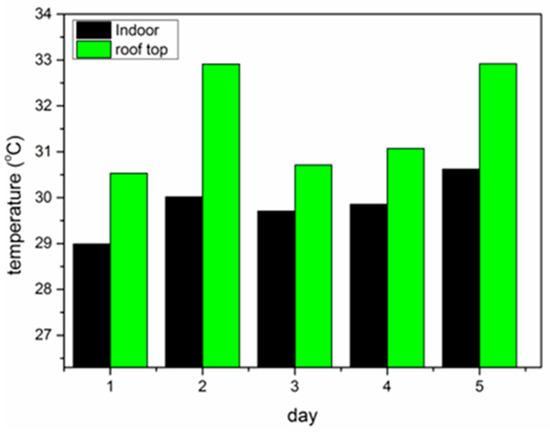Abstract
The room temperature that suits the needs will create a comfortable working environment for the occupants. However, an increase in the temperature outside can increase the temperature in the room. Control of heat spread from outside to inside is needed to keep the room temperature stable and avoid significant temperature rises. This study aims to examine the heat dissipation due to the concrete roof and the presence of a gypsum ceiling, and its effect on the temperature of the room below. Methods are applied to this study by making observations to obtain research data. The results showed that heat dissipation by the concrete roof had reduced the indoor temperature to as low as 0.180 °C. The addition of gypsum ceiling under the concrete slab roof at 50 cm has reduced the room temperature by 1.79 °C from the temperature above the roof.
1. Introduction
Surakarta is in Indonesia, an area located on the equator that receives approximately 12 h of sunlight per day. This causes this region to have a tropical climate characterized by high humidity and air temperature, as well as scorching sun rays [1]. Sunlight is needed for lighting in the house and the health of its inhabitants. However, the light also carries heat which affects the high room temperature in the house [2]. The air temperature outside the house can propagate and affect the temperature inside the house [3]. Generally, to overcome the high temperature in the room, people use Air Condition (AC) devices [4]. Surveys in Indonesia reveal that in the household sector, air conditioning systems are the second rank of equipment that consumes the most electrical energy after cold storage [5]. Seeing this reality, concern is needed for efforts to get natural cooling in the household sector to reduce the use of electrical energy.
The roof covering material can be used to modify the room’s internal temperature below it [6]. Different materials have different abilities in controlling heat propagation from outside to inside the house. Therefore, selecting the right roofing material will enable the production and maintenance of a comfortable internal temperature in various external conditions. If the room temperature has met the comfort requirements, then air conditioning is not required. The impact of this condition is the saving of electrical energy. The thicker the roof covering material, the greater its ability to absorb heat from outside the house [6]. Houses with concrete slab roofs generally have a roof thickness of 1012 cm. The use of a thicker plate roof covering is expected to be able to absorb heat better than the thinner ones. A layer of gypsum ceiling under the roof at a certain distance will increase heat dissipation from the roof to the room. The space between the concrete slab roof and the ceiling layer at a certain distance creates an air cavity that can function as an insulation space to reduce the heat transfer rate [7].
Indonesia has a tropical climate characterized by high air humidity, reaching humidity above 90%, air temperature is also relatively high, between 15 to 35 °C, with scorching solar radiation, and high rainfall that can reach numbers above 3000 mm/year. These climatic factors have a very large impact on aspects of thermal comfort on the human physique. Human productivity tends to decrease or be low in uncomfortable air conditions, either too cold or too hot. Space must fulfil two dominant aspects to produce physical comfort for residents of houses in the tropics, namely thermal comfort and visual (lighting) comfort. Thermal comfort is very influential in everyday human life. If there is a temperature stimulus that is too high or too low for the body, the taste sensor will convey information to the brain which responds by instructing certain body parts to react to maintain body temperature at around 37 °C. Organs in the human body can carry out their functions properly in this temperature range. The room temperature range that is considered comfortable for humans living in tropical climates is between 24 to 30 °C [1].
Surakarta has a relatively comfortable air temperature for residents of the tropics to live in. The average minimum and maximum annual temperatures in Surakarta and its surroundings are 21.8 °C and 31.4 °C as shown in Figure 1. If the temperature inside the house is maintained close to the temperature outside the house, this condition already provides thermal comfort. to the occupants of the house. However, because the architecture of the house is often not designed to have adequate natural ventilation, and the air is not forced to circulate properly in the house, the thermal comfort of the building for the occupants is not achieved [8].

Figure 1.
The average monthly temperature of Surakarta, minimum and maximum.
Figure 1 shows that the maximum monthly average temperature in Surakarta occurs in October and the minimum in January. Meanwhile, the average annual maximum temperature reaches 31.4 °C, and vice versa the minimum temperature is 21.8 °C.
Room temperature in house buildings is caused by two heat loads, namely internal loads (due to occupant activities) and external loads (due to air temperature outside the building) [9]. Building shells such as walls, roofs, and natural ventilation significantly affect the room temperature in the house. The mode of heat transfer in which heat flows from areas of higher temperature to areas of lower temperature in a medium (solid, liquid, gas) or between different media that are in direct contact is called conduction. Conduction is the only mechanism by which heat can flow in an opaque solid.
Consumption of electrical energy in households tends to be wasteful because people cannot regulate the consumption of electrical energy in households. Electrical energy consumption can be reduced if energy use has been planned beforehand [3,10]. Residential electricity consumption which is used to overcome the room heat temperature reaches 40% of the total use of residential electrical energy. This is due to the presence of the skin aspect of the building which does not function as a passive cooling system [10]. The roof of the house has a functional and aesthetic role. The roof serves as the main protection from the adverse effects of the climate because it is the part of the building that is most exposed to heat and rain. Aesthetically, the roof is an element that greatly determines the characteristics or character of a building [9]. An interesting challenge for designers and building construction implementers in tropical climate areas such as Indonesia is how to create a room temperature below 28.3 °C, which is the upper limit for a comfortable warm sensation, when the outside air temperature is around 32 °C during the day. The provision of gypsum and aluminum-foil ceilings on zinc roofs can reduce room temperature between 0.5 to 2 °C compared to plain roofs without aluminum-foil and ceilings. This decrease in temperature occurs because the ceiling layer and aluminum-foil block solar radiation and is not directly transmitted into the room [11].
2. Methodology
This study employs a methodology that involves observing and collecting air temperature data as an indicator of room temperature. Air temperature measurements are conducted using a thermometer, both indoors and on the roof of the house. The room measures 3×6 m (18 m²) and is enclosed on three sides by plastered brick walls, with one side serving as an entry/exit point with windows. Measurements are taken under two conditions: a concrete roof without a ceiling and a concrete roof with a gypsum ceiling. Temperature readings inside the room are recorded at the center, at an average height of 150–170 cm, representing the typical height of an Indonesian individual. Simultaneously, measurements on the roof are taken directly above the indoor measurement point at the same height (150–170 cm) from the concrete roof surface.
The data collection took place in Surakarta, Indonesia, spanning six days, with readings taken during peak daily temperatures and two hours before and after the peak—at 11:00 AM, 12:00 PM, 1:00 PM, 2:00 PM, and 3:00 PM—in April and August 2021. These months were chosen because their air temperatures closely align with the annual average temperature. The study utilizes an Environment Meter (KW06-291, Krisbow, Jakarta, Indonesia) with a temperature range of −20 °C to 750 °C (−4 °F to 1400 °F). Data analysis is conducted using IBM SPSS Statistics v26 software to calculate the average index of each recorded measurement. The primary parameters analyzed include the reduction in room temperature after adding the ceiling layer and the extent to which room temperature aligns with thermal comfort conditions for house occupants.
3. Results and Discussion
Data from measurements of the average outside (roof) air temperature shown in Figure 2, which was measured in August 2021, shows figures ranging from 29.26 °C to 30.58 °C or an average value of 29.94°C. Figure 3 also displays data from outdoor air temperature measurements measured in April 2021 showing results between 30.44 °C to 33.15 °C or with an average value of 31.65 °C. When compared with Figure 1, the average minimum and maximum monthly temperatures for Surakarta in the same month align well with these two measurement data points. This consistency indicates that the measuring instrument used performs reliably, producing accurate and credible measurement results.

Figure 2.
Temperature difference indoors and outdoors on a concrete roof.

Figure 3.
Temperature difference indoors and on a concrete roof + gypsum Ceiling.
A comparison of data from temperature measurements in the room and on the concrete roof is shown in Figure 2. Observing the data reveals a difference in temperature between the concrete roof and the room beneath it. The average temperature on the concrete roof is 29.94 °C, and the average temperature in the room under the concrete roof is 29.80 °C. There is a difference of 0.14 °C lower. This shows that the concrete slab above the room causes heat reduction. The heat from the outside air that hits the concrete roof is received by the concrete roof and heat propagation occurs in the 12 cm thick concrete slab. This heat is partly transferred by concrete to the indoor air and partly absorbed by the concrete roof. This is indicated by the difference in temperature above and below the concrete roof.
Data from room temperature measurements and concrete roof measurements under conditions where a gypsum ceiling is present beneath the roof show different results. The heat dissipation that occurs is greater. This can be seen in Figure 3, where the difference in room temperature in conditions without a gypsum ceiling, with the temperature on the roof is only 0.14 °C. By adding a gypsum ceiling under the concrete roof, the difference between the room temperature and the temperature above the roof reached 1.93 °C or increased 13.8 times. This shows that the heat dissipation that occurs with a gypsum ceiling is more effective than without a ceiling.
Figure 4 shows the difference in heat absorption by a concrete roof and a concrete roof + gypsum ceiling. The two graphs show that at higher temperature, heat reduction shows a better level of effectiveness. This can be seen on days 2 and 5 where the outdoor temperature is maximum, the damping value is also maximum, and on day 3 when the outside temperature is low, the damping level by the concrete and gypsum layer also decreases. Figure 4 also shows that adding a layer of gypsum is quite effective in increasing heat absorption in houses with concrete roofs.

Figure 4.
Differences in heat absorption by concrete roofs and concrete roofs + gypsum ceilings.
In the previous study (Table 1), it is known that the average indoor temperature in houses with roofs made of different materials shows numbers that indicate differences in attenuation by roofing materials with tile, asbestos, and galvalume. The average temperature in a house made of galvalume roof is 31.48 °C, that of asbestos roof is 31.10 °C and that of tile roof is 30.01 °C [6]. Meanwhile, the average room temperature in a house with a concrete roof is 29.80 °C. Thus, when viewed from the comfort of space as a place of activity, houses with concrete roofs are more comfortable than houses with roofs made of tile, asbestos and galvalume. Heat dissipation by concrete roofs is more effective than tile roofs, asbestos roofs and galvalume roofs. Because the room temperature range that is considered comfortable for humans who live in tropical climates is between 24 to 30 °C, with a concrete roof that can produce a room temperature of 29.80 °C, it has produced a comfortable room for work.

Table 1.
Room temperature in houses made of different roofs.
4. Conclusions
Heat dissipation by the concrete roof has reduced the indoor temperature to as low as 0.14 °C and the addition of a gypsum ceiling under the concrete slab roof with 50 cm has reduced the room temperature by 1.93 °C from the temperature above the roof. The room temperature range that is considered comfortable for humans living in tropical climates is between 24 to 30 °C. Thus a concrete roof with a gypsum ceiling that can produce a room temperature of 29.80 °C, has produced a comfortable room to work in.
Author Contributions
Conceptualization, B.P. and N.H.; methodology, B.P.; software, K.M.W.; validation, B.P., N.H., and I.; formal analysis, B.P.; investigation, B.P.; resources, B.P.; data curation, K.M.W.; writing—original draft preparation, B.P.; writing—review and editing, N.H. and I.; visualization, K.M.W.; supervision, B.P.; project administration, B.P.; funding acquisition, N.H. All authors have read and agreed to the published version of the manuscript.
Funding
This research was funded by Universitas Muhammadiyah Surakarta. The APC was also covered by Universitas Muhammadiyah Surakarta.
Institutional Review Board Statement
Not applicable.
Informed Consent Statement
Not applicable.
Data Availability Statement
The data presented in this study are available on request from the corresponding author at bp225@ums.ac.id.
Conflicts of Interest
The authors declare no conflict of interest.
References
- Karyono, T.H. Kenyamanan Termal dalam Arsitektur Tropis. 2010. Available online: https://www.researchgate.net/publication/305189048_KENYAMANAN_TERMAL_DALAM_ARSITEKTUR_TROPIS (accessed on 1 January 2025).
- Kuruseng, H.; Ajrinah, S.; Wahyuni, A.; Syari, E. Orientasi Rumah dan Pengaruhnya terhadap Suhu dalam Ruang pada Perumahan Gapura Satelit Indah. In Prosiding Temu Ilmiah IPLBI 2017; Universitas Malikussaleh: Lhokseumawe, Indonesia, 2017; pp. H029–H032. [Google Scholar]
- Rushayati, S.B.; Shamila, A.D.; Prasetyo, L.B. The Role of Vegetation in Controlling Air Temperature Resulting from Urban Heat Island. Forum Geogr. 2018, 32, 1–11. [Google Scholar] [CrossRef]
- DPPB Air Conditioning and Ventilation System. Available online: https://greenbuilding.jakarta.go.id/files/userguides/Vol-2-Airconditioning-Ventilation-UserGuide.pdf (accessed on 1 January 2025).
- Batih, H.; Sorapipatana, C. Characteristics of urban households’ electrical energy consumption in Indonesia and its saving potentials. Renew. Sustain. Energy Rev. 2016, 57, 1160–1173. [Google Scholar] [CrossRef]
- Priyanto, B.; Hafittuloh, R.N. The effect of roof tiles materials on roof truss construction and room temperature. AIP Conf. Proc. 2019, 2114, 1–7. [Google Scholar] [CrossRef]
- Nahar, N.M.; Sharma, P.; Purohit, M.M. Performance of different passive techniques for cooling of buildings in arid regions. Build. Environ. 2003, 38, 109–116. [Google Scholar] [CrossRef]
- Etheridge, D. Natural Ventilation of Buildings: Theory, Measurement and Design; John Wiley & Sons, Ltd.: Hoboken, NJ, USA, 2011. [Google Scholar] [CrossRef]
- Arsitektur, J.; Teknik, F.; Semarang, U.D.; Listrik, E.; Tinggal, R.; Design, G. Profil Penutup Atap Genteng Beton Dalam Effesiensi Konsumsi Energi Listrik Pada Skala Rumah Tinggal. Modul 2013, 13, 23–34. [Google Scholar]
- Purbaningrum, S.P. Audit Energi dan Analisis Peluang Penghematan Konsumsi Energi Listrik Pada Rumah Tangga. Media Mesin Maj. Tek. Mesin 2016, 15, 1. [Google Scholar] [CrossRef]
- Givoni, B. Indoor temperature reduction by passive cooling systems. Sol. Energy 2011, 85, 1692–1726. [Google Scholar] [CrossRef]
Disclaimer/Publisher’s Note: The statements, opinions and data contained in all publications are solely those of the individual author(s) and contributor(s) and not of MDPI and/or the editor(s). MDPI and/or the editor(s) disclaim responsibility for any injury to people or property resulting from any ideas, methods, instructions or products referred to in the content. |
© 2025 by the authors. Licensee MDPI, Basel, Switzerland. This article is an open access article distributed under the terms and conditions of the Creative Commons Attribution (CC BY) license (https://creativecommons.org/licenses/by/4.0/).